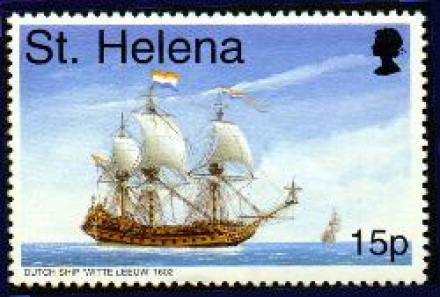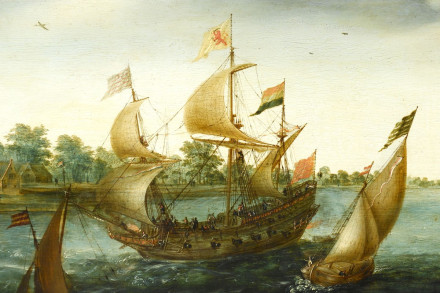History
The Witte Leeuw was part of the fleet that sailed out of Texel in the Netherlands on 30 Januari 1610 under the first Governor General of the Dutch East India Company (VOC) - Pieter Both.
The Witte Leeuw was lost on 13 June 1613, on her way back to the Netherlands from the East. . Her cargo contained valuable spices and porcelain. She was drawn into a fight with Portuguese carracks near Saint Helena, and burned. Part of the remaining crew sailed back to the Netherlands on board the Vlissingen and the Bantam. The Witte Leeuw is presently the only known Dutch shipwreck in Saint Helena.

In 1998 the post office of Saint Helena designed a series of stamps to honour the rich maritime heritage of the island. Stamps were designed depicting different types of ships. One of these was a painting of the Dutch ship Witte Leeuw.

Description
Yard: Peperwerf, Amsterdam
According to the resolutions of the Amsterdam chamber of Mach 13, 1609, the dimensions of the Witte Leeuw were 'long within the sterns 130 feet, wide 37 feet and deep 15 feet, and the bridge high feet'.(1)

| Skipper | Roelof Simonsz. de Bloem |
|---|---|
| Length | 130 Amsterdam feet (36.8 m) |
| Width | 35 Amsterdam feet (9.9 m) |
| Tonnage | 640 ton (320 last) |
Status
The wreck of Witte Leeuw was discovered in 1977 by Belgian diver R. Stenuit. It lay at a depth of 36 metres in the Bay of Jamestown in Saint Helena. Stenuit later received a contract with the government of St. Helena regarding the salvage of the wreck. The wreck had been physically protected during the years since her sinking as she was buried under a thick layer of mud. Because of this, the timber of the ship was in relatively good condition when the wreck was excavated. The wreck also lies at a sufficient depth to prevent a high level of human impact, further ensuring her preservation.
When the archaeological finds were examined, they revealed the standard cargo of a VOC ship. A large number of spices and porcelain were found, providing a clear example of the purpose and function of the ship in the trade between the Dutch East Indies and the Netherlands. Some of the finds recovered were sold at auction in London, and some were acquired by the Rijksmuseum in Amsterdam.
References
- Dutch-Asiatic Shipping.
DAS 5100.3. - Commelin, Isaac (1646).
Begin ende voortgangh van de Vereenighde Nederlantsche geoctroyeerde Oost-Indische compagnie.
Janssonius Amsterdam. - Robert Stenuit (1977).
De 'Witte Leeuw'. De schipbreuk van een schip van de VOC in 1613 en het onderwateronderzoek naar het wrak in 1976.
Bulletin van het Rijksmuseum 25 (1977).
pp 165-178. - Nationaal Arcief.
NA 1.04.02 (VOC).
100. - J.B. Kist (1977).
‘De "Witte Leeuw"’.
Bulletin van het Rijksmuseum 25 (1977).
pp 163-164. - Robert Stenuit (1978).
The sunken treasure of St. Helena.
National Geographic (10). - C.L. van der Pijl-Ketel (1982).
The Ceramic Load of the ‘Witte Leeuw’(1613).
Amsterdam. - ‘Het project de 'Witte Leeuw' : de catalogus van de ceramische wrakvondsten: The Ceramic Load of the 'Witte Leeuw'’ (1982).
C.L. van der Pijl-Ketel.
Bulletin van het Rijksmuseum 30 (1982).
pp 210-211.